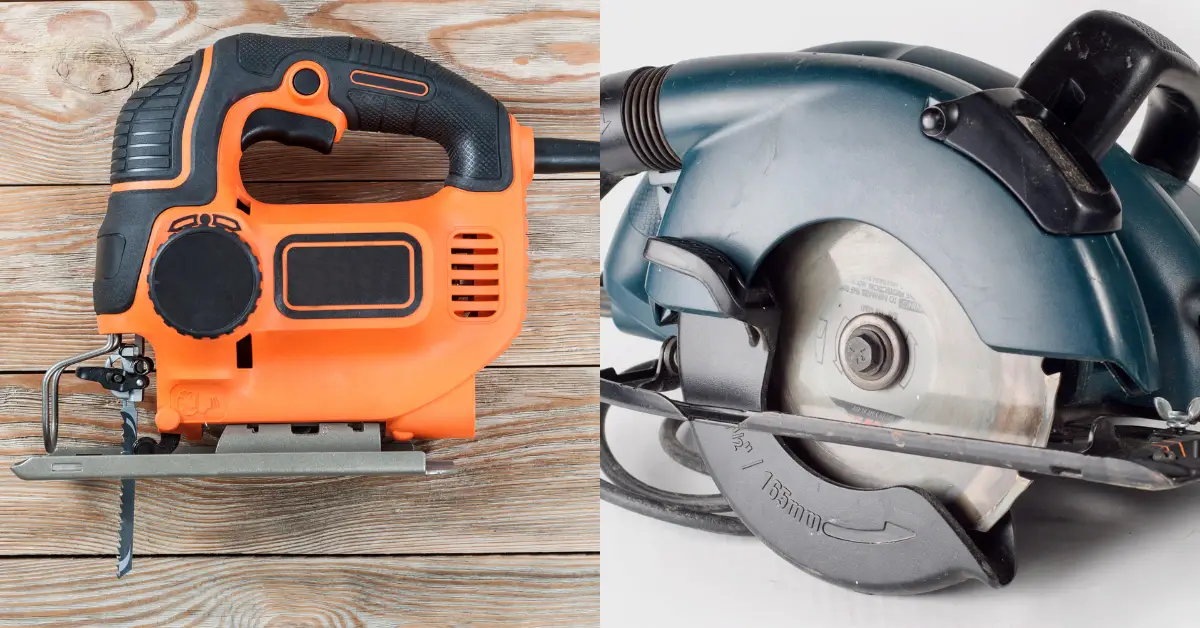Power Tools
Jigsaw vs Circular Saw
Circular saws and jigsaws are incredibly versatile power tools in any woodworker's workshop since they are more than just tools for cutting wood.
Nevertheless, you have to choose the correct tool for a given task as a woodworker since this could be the difference between a professional-looking and shoddy job. For this reason, we've written this piece that will clearly show the difference between jigsaws and circular saws. By the time you're done reading, you'll be able to choose the most suitable saw for your particular project.
Let's get started!
Jigsaw overview
This is a somewhat compact and lightweight power tool featuring a sharp blade with an up-and-down slicing motion. Plus, thanks to the lightweight and compact construction, it is a handheld tool.
Typically, jigsaws are ideal for making curves and patterns on a given material, which you cannot achieve using a circular saw. Again, jigsaws are safer to use compared to circular saws. Even though it's possible to injure yourself using a jigsaw, there is a reduced risk of causing serious harm as the jigsaw's blade is smaller.
Again, they don't generate a lot of dust, and their blades are affordable.
Jigsaw uses
Here are some ways a jigsaw could come in handy;
It is compatible with a wide array of blades and thus can be used to cut all types of wood.
Freehand cutting where the cuts don't need to be accurate
Slicing through a temporary barrier accurately
When you install an adjustable side fence, you can make cuts parallel to any edge.
Creating bevel cuts which can be achieved through changing the blade's angle
Creating sweeping curves by freehand sawing or by using a fastened compass
Cutting through the interior of any wood without interfering with its exterior
Pros
Great for making curves
User-friendly and lightweight
Affordable
It's extremely versatile since it can create a wide range of cuts
Perfect for tasks that require less accuracy
Cons
It has thin blades which are susceptible to breaking
Cheaper jigsaws usually work with a lot of noise and vibration
Cannot make accurate cuts easily
Circular saw overview
A circular saw is a handheld, more compact version of a table saw, and it is exclusively engineered to create accurate, straight cuts on various materials. When it comes to making cuts on larger boards, the circular saw is indispensable.
Additionally, it comes in handy in various home and construction site repairs.
Circular saw uses
Circular saws are a compact table saw versions; they can do almost everything a table saw can. The kinds of cuts you can create using this saw are;
Bevel cuts
Rip cuts
Freehand cuts
Cross-cuts
Miter cuts
Besides, similar to table saws, they are compatible with a handful of blades to facilitate cutting more specialized cuts. Here are some uses for certain blades;
Chisel-toothed blades come in handy for crosscutting and ripping; thus, they're the go-to all-in-one blades.
Blades with pointed teeth are perfect for making crosscuts on hardwood, and they make a neat finish.
Rip blades feature tungsten carbide, meaning they're ideal for ripping softer timber.
Blades with fine teeth don't cut very fast, which is why they are a suitable option for plastic-laminated and chipboards.
Pros
Perfect for thicker timber
More power and speed compared to jigsaws
Great for making accurate straight cuts
The blades are robust and durable
Cons
Heavy thus less portable
Only makes straight cuts
When to go for a jigsaw
In terms of looks, circular saws and jigsaws have completely different designs; therefore, you wouldn't confuse one for the other.
For example, jigsaws have an elongated thin blade, like a serrated knife's, and it slices in a swift up-and-down movement. It is engineered to make different kinds of cuts, though this relies on the blade you use. Besides, a jigsaw is constructed to cut through numerous materials.
It is among the most flexible tools, thanks to the numerous cuts it can make. From extended straight cuts to bevel and curved cuts, this tool is capable of almost anything. Truth be told, this is usually the go-to power tool for making curves, and it can cut through the interior of a given surface without touching the exterior.
Furthermore, jigsaws can as well cut a wide range of materials, including hardwood and softwood, countertops, particleboard, ceramic tile, plywood, metal, and plastic. However, the blade you use will determine the quality of the cuts you make on these materials.
Some of the blades you can use with a jigsaw include reverse tooth, progressive tooth, U-shank, and regular TPI blades. Also, when you want to pick the right blade, you should know that the blades equipped with huge but few teeth are most suitable for swift cuts, though they will leave behind a course edge. On the other hand, blades featuring small teeth are gradual but lead to a smoother finish.
When to go for a circular saw
A circular saw has a circular blade that revolves very fast to make extended straight cuts effortlessly.
It can slice through various materials such as masonry, metals, wood, roofing, and sheet materials. However, the quality of the cuts you make relies on the blade you pick. Most circular saw blades have 24 teeth, though a blade with more teeth, say 50 to 60, makes neater cuts.
The regular 24-teethed blade functions impressively on timber. All the same, ensure you utilize a diamond blade when working with masonry materials. Again, go for a carbide blade with fine teeth for pipes, excluding those made of cast iron. For this and other thin metals, use a metal-cutting specific blade.
In terms of curved cuts, this saw is certainly not the ideal selection. And while circular saws are not as safe to use as jigsaws, you can always avoid injuring yourself with proper safety precautions.
Why You Should Trust Us
At Woodworking Tool Guide, we know one size doesn't fit all! We cater to every woodworker, from beginner to pro, with insights and recommendations tailored to your skill level, project needs, and budget. We take the guesswork out of choosing the right tools, whether you're tackling your first crafting a masterpiece for the ages. So grab your chisel, join our community, and let's build something amazing together!
Woodworking Tool Guide wasn't just born, it sprouted from a seed of passion for the craft. What started as a joyful exploration blossomed into a trusted online haven for fellow enthusiasts like you. We pour our love into meticulously chosen review selections, meticulous hands-on testing, and lab-backed insights, all to empower you with reliable, comprehensive information you can build on. So, grab your tools, trust our guidance, and let's build something beautiful together!
Passion-Driven Expertise
Our journey started with a shared love for woodworking. The team behind the Woodworking Tool Guide is comprised of individuals who are not just writers but passionate woodworkers themselves. This shared enthusiasm ensures that our content is crafted with a deep understanding of the craft and an authentic appreciation for quality tools.
Top Tool Guides Online
Woodworking Tool Guide has rapidly ascended to become one of the premier online destinations for tool guidance. Our commitment to excellence and the accuracy of our information has positioned us as a reliable source for both beginners and seasoned woodworkers seeking trustworthy advice on the best tools for their projects.
User-Centric Approach
Our content caters to every woodworker, from rookies just starting out to seasoned pros tackling intricate projects. We tailor our insights and recommendations to your skill level, project needs, and budget, ensuring you find the perfect tools to match your unique woodworking journey. So step into your workshop, grab your tool belt, and let Woodworking Tool Guide be your trusted companion as you craft your masterpieces.
Continuous Support and Innovation
Woodworking is an ever-evolving craft, and so is our commitment to supporting you. We are dedicated to bringing you the latest information on woodworking tools, techniques, and trends. Our team is actively working to expand our content and bring you more valuable insights, ensuring that you stay well-informed in your woodworking adventure.
Hands-On Experience
Ditch the endless research rabbit hole! At Woodworking Tool Guide, we believe in actionable advice, not armchair analysis. We get our hands dirty, putting every tool through its paces in real-world woodworking scenarios. Whether it's the precision of a table saw, the versatility of a router, or the tactile satisfaction of a handplane, we test for performance, durability, and user-friendliness. No more sifting through dry specs – we deliver practical insights you can trust to transform your woodworking dreams into reality.
Woodworking Tool Guide isn't just a review site, it's your trusted companion on the sawdust-filled path to woodworking mastery. Our expert team, led by veteran David Jones, meticulously tests and explains tools in terms you understand. We cut through the jargon, bias, and confusion with real-world insights and honest evaluations. Join our passionate community, where decades of experience, cutting-edge knowledge, and shared love for the craft come together to guide you every step of the way. So grab your chisel, buckle up, and let's embark on this exciting woodworking adventure, together!
Conclusion
The circular and jigsaw are valuable assets to have in your garage or workshop, and they serve different purposes. As you have seen in this write-up, you can't really tell which one is better since they're both different and excellent at what they do.
A circular saw is ideal for cutting straight cuts through wood and other material, while a jigsaw will come in handy with complex cuts and curves.





